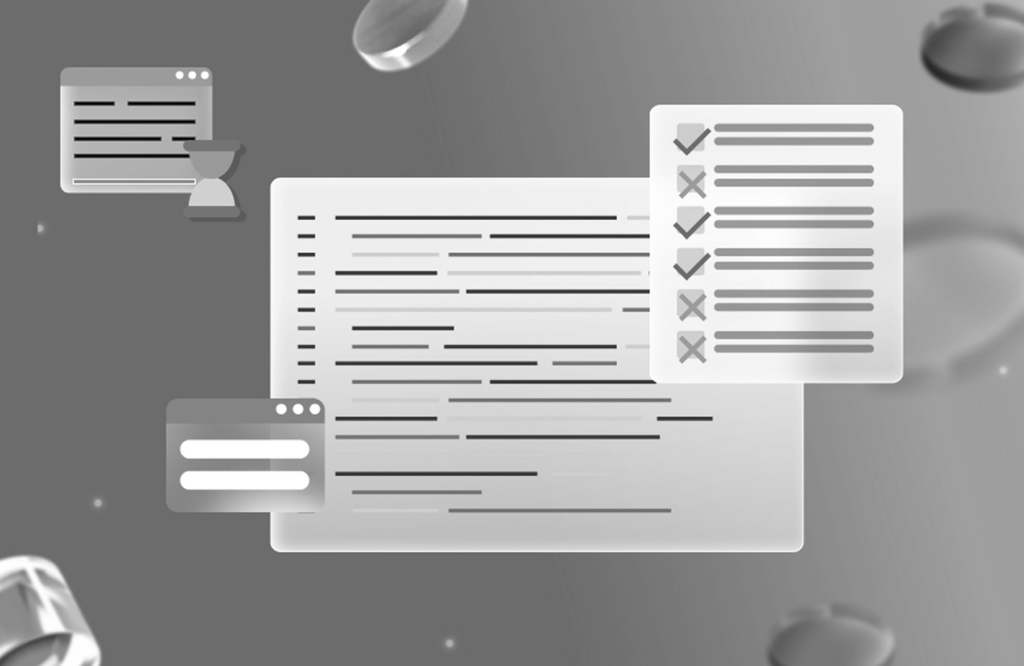Testing Documentation: Benefits, Use Cases, and Best Practices


Software testing is a critical phase in the software development process, aimed at verifying that the software functions as intended and meets user requirements. This process involves identifying bugs, performance issues, and any discrepancies from the specified requirements. Within the software testing process, documentation holds a significant position.
What Is Test Documentation?
You might be familiar with software testing, but what exactly is test documentation? Test documentation refers to any documents produced during the testing phase of the software development process. These documents enable the QA team to test the product effectively and ensure it meets the specified requirements.

Software test documents encompass artifacts created before, during, and after the testing phase. These artifacts include records and plans for testing tasks, keeping testers informed about the current state of software testing. Test documents are essential for formulating a coherent plan to thoroughly test a software product, systematically design and implement tests, and accurately record results.
Importance of Test Documentation
Regardless of your role-whether you’re a C-level executive, developer, test engineer, QA analyst, or a member of the product team-understanding the value of test documentation is crucial. Comprehensive internal documentation promotes seamless knowledge sharing within the team, ensuring everyone is aligned and facilitating effective collaboration throughout the testing process.
Test documentation should be integral to your definition of done. For instance, a feature should not be tested until it has the requisite documentation in place. This documentation is critical, providing the QA team with the necessary details, such as a software requirements specification, to conduct effective testing.

Having the appropriate test documentation eliminates confusion and reduces the anxiety often associated with the testing phase of a software project. When the entire testing team has access to the relevant documents, they clearly understand what needs to be tested and have detailed plans outlining how the testing should be executed.
Key Benefits of Test Documentation:
- Saves Time: Clearly articulates tasks for engineers, analysts, and other team members, preventing the overuse of resources and reducing the time spent revisiting previously decided topics.
- Enhances Efficiency: Streamlines the testing process by providing clear guidelines and reducing redundancy, thus improving overall test efficiency.
- Maintains Records: Keeps a detailed record of changes made to the software and any bugs encountered, facilitating better tracking and management of issues.
- Supports Onboarding: Helps new team members quickly get up to speed with the testing phase by providing comprehensive documentation.
- Meets Client Requirements: Many clients require detailed test documentation to ensure the successful completion of the software project.
By integrating comprehensive test documentation into your workflow, you ensure a structured and thorough approach to testing, which ultimately leads to higher-quality software and more efficient development cycles.
Role of Documentation in the Software Testing Life Cycle (STLC)
Although creating documentation may not be the most thrilling task for many development teams, it is indispensable for the success of the software testing life cycle (STLC). Manual testers, test engineers, functional testers, and QA analysts rely heavily on comprehensive and accurate documentation to achieve their testing objectives.
In the STLC, documentation starts early and evolves through various stages:
- Requirement Analysis: During this stage, the initial test documentation is created, including the test plan, which outlines the strategy, objectives, resources, schedule, and scope of testing activities.
- Test Planning: Detailed test plans and test cases are developed. These documents specify the conditions under which a test will be executed, the input data to be used, and the expected outcome.
- Test Case Development: Test cases and test scripts are further refined and detailed, ensuring they cover all functional and non-functional requirements.
- Test Environment Setup: Documentation includes details on the required hardware and software configurations, as well as any other setup needed to perform the tests.
- Test Execution: During this phase, the results of test execution are documented meticulously. This includes logging test results, defects found, and their status.
- Test Cycle Closure: Finally, test reports and metrics are documented, providing a summary of the testing activities, defect analysis, and overall software quality assessment.
[blog-subscribe]
Value of Testing Documentation
For software teams that recognize the importance of rigorous testing, documentation becomes essential. It enables teams to systematically identify and address bugs, performance issues, and functionality problems. Effective test documentation ensures consistency, repeatability, and comprehensiveness in testing, ultimately leading to higher-quality software and a better user experience.
Comprehensive test documentation provides several key benefits:
- Traceability: It allows for the tracking of requirements throughout the testing process, ensuring that all requirements are covered by test cases and that all test cases are executed.
- Accountability: With well-documented test plans and cases, team members know their responsibilities and can be held accountable for their tasks.
- Reusability: Test cases and scripts can be reused for future projects or for regression testing, saving time and resources.
- Communication: Clear documentation facilitates communication among team members and stakeholders, ensuring everyone is aligned on the testing objectives and results.
- Auditability: Documentation provides a record for audits and compliance purposes, demonstrating that the software has been tested rigorously.
Benefits of Testing Documentation
Improved Communication and Clarity
Testing documentation serves as a vital communication tool among project stakeholders, including developers, testers, managers, and clients. It helps to clearly define the scope, objectives, and requirements of the testing process.
- Clear Objectives: Documentation outlines what needs to be tested, how it will be tested, and the expected outcomes.
- Stakeholder Alignment: Ensures everyone involved in the project is on the same page regarding the testing processes and goals.

Enhanced Test Coverage
Comprehensive test documentation in software testing ensures that all functional and non-functional aspects of the software are covered. This reduces the risk of missing critical defects.
- Systematic Approach: Documented tests ensure a thorough and methodical approach.
- Traceability: Each requirement can be traced back to specific tests, ensuring nothing is overlooked.
Facilitation of Regression Testing
When software evolves, previously documented tests can be reused to ensure new changes haven’t introduced new defects. This is particularly crucial in agile environments where continuous integration and delivery are practiced.
- Reusability: Existing test cases can be reused, saving time and resources.
- Consistency: Ensures consistent testing across different stages of development.
Knowledge Preservation
QA testing documentation serves as a repository of knowledge, preserving critical information about the testing process, methodologies, and outcomes. This is invaluable for onboarding new team members or for future reference.
- Historical Reference: Documentation provides a historical reference of what was tested and the outcomes.
- Training Resource: New team members can refer to past documentation to understand testing practices and standards.
Types of Test Documentation
Test Plan
A test plan outlines the strategy, scope, resources, and schedule for the testing activities. It is a high-level document that guides the entire testing process.
- Scope and Objectives: Defines what will be tested and the testing objectives.
- Resources and Schedule: Details the resources required and the timeline for testing activities.
Test Case Documentation
Test case documentation includes detailed descriptions of individual test cases, specifying the inputs, execution steps, expected results, and actual outcomes.
- Detailed Steps: Step-by-step instructions to execute the test.
- Expected vs. Actual Results: Clearly defines the expected outcome and provides a space to document the actual result.
Test Requirements Document
A test requirements document lists all the requirements that need to be tested, serving as a foundation for creating test cases.
- Requirement Identification: Each requirement is uniquely identified.
- Testable Criteria: Defines how each requirement will be tested.
Test Summary Report
This report provides an overview of the testing activities, including what was tested, how it was tested, the outcomes, and any deviations from the plan.
- Test Coverage: Summarizes the areas tested and the extent of coverage.
- Results and Metrics: Provides detailed results and metrics on test outcomes.
Defect Report
A defect report documents any issues or bugs found during testing, including steps to reproduce, severity, and status.
- Defect Details: Includes all necessary details to reproduce and understand the defect.
- Tracking and Resolution: Helps in tracking the defect until it is resolved.
Best Practices for Testing Documentation
Creating effective testing documentation is essential for ensuring that the testing process is both efficient and comprehensive. Here are some best practices to follow:
Be Clear and Concise
Documentation should be easy to understand and precise. Use simple language and clear formatting to enhance clarity. Keep your documentation concise by avoiding unnecessary information and focusing only on essential details.
Maintain Consistency
Consistency in terminology, structure, and format is crucial for maintaining high-quality documentation. Using standardized templates can help ensure uniformity across all documents. Additionally, using the same terms throughout the documentation prevents confusion and promotes understanding among team members.
Keep It Up-to-Date
Regularly updating your documentation to reflect changes in the software or testing processes is vital. Employ version control systems to track changes and schedule regular reviews to keep the documentation current and accurate.
Include Visuals
Incorporate diagrams, flowcharts, and screenshots where applicable to complement the text. Visual aids can significantly enhance understanding, while step-by-step guides with screenshots can illustrate complex steps or processes more effectively.
Automate Where Possible
Automating the generation of certain documentation aspects, like test case execution results, can save time and reduce errors. Utilize automated reports to generate test execution results and integrate documentation updates into the continuous integration/continuous deployment (CI/CD) pipeline to streamline the process.
Use Cases of Testing Documentation
Large-Scale Projects
In large-scale projects, detailed testing documentation ensures all team members understand the testing process and objectives, which is crucial for coordination and effective execution.

Regulatory Compliance
In industries like healthcare or finance, comprehensive test documentation in software testing is often a regulatory requirement.
- Compliance: Ensures adherence to industry standards and regulations.
- Audit Trails: Provides an audit trail for regulatory bodies.
Agile and DevOps Environments
Even in agile and DevOps environments, where speed and flexibility are key, maintaining QA testing documentation is critical for ensuring quality and facilitating continuous improvement.
- Agility: Supports fast-paced development cycles.
- Continuous Improvement: Helps in tracking progress and identifying areas for improvement.
Legacy Systems
For maintaining and updating legacy systems, testing documentation provides essential insights into existing functionalities and testing practices.
- Knowledge Transfer: Aids in transferring knowledge about legacy systems.
- Maintenance: Helps in maintaining and upgrading legacy systems efficiently.
Conclusion
Effective testing documentation is essential for the success of any software project. It enhances communication, ensures comprehensive test coverage, facilitates regression testing, and preserves knowledge. Well-maintained documentation serves as a single source of truth, helping teams understand the testing scope, objectives, and outcomes. By following best practices such as maintaining clarity, consistency, and up-to-date documentation and by leveraging automation where possible, teams can significantly improve their testing processes. Automation in documentation reduces manual effort and error, allowing for more efficient tracking and updating of test cases and results.
Whether for large-scale projects, regulatory compliance, agile environments, or legacy systems, robust testing documentation is invaluable. It not only helps in meeting compliance and quality standards but also accelerates the onboarding of new team members and supports better decision-making throughout the software development lifecycle. Effective documentation ultimately contributes to higher software quality, reduced risk of defects, and a more streamlined development process.



